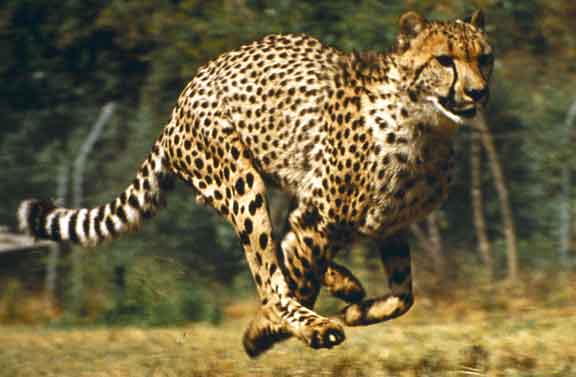 III.
Cellular Respiration
III.
Cellular Respiration
 III.
Cellular Respiration
III.
Cellular Respiration In this lecture, we will examine the energy harvesting reactions that ALL living cells perform: Cellular Respiration. In other words, "what happens to the food you eat?" And, "what happens to the oxygen you breather in?" All living cells - eubacteria, archaea, protists, fungi, plants, and animals - can harvest the energy contained in the chemical bonds of complex organic molecules. When the covalent bonds between carbon atoms in these molecules are broken, energy is released; some of this energy is used to bind ADP + P --> ATP in coupled reactions. As such, some of the chemical energy in the covalent bonds of the initial organic molecules is transformed into chemical energy in covalent bonds of ATP.
Why??? Well, carbon-carbon bonds are very strong and stable; enzymes cannot access this energy in this form. In contrast, phosphate bonds in ATP are much weaker--they are more easily broken and all enzymes can break these bonds and use that energy to catalyze their reactions. Think about it this way: as you learned in high school, the breadown of glucose into CO2 and H2O releases enough energy to make 30-38 molecules of ATP. So, think about that... if you have a linear molecule of glucose, the six carbons are linked together by 5 carbon-carbon bonds. Breaking those five bonds releases enough energy to make 30-38 bonds between ADP and free phosphate molecules. And, that's even while losing some energy to entropy (second law - no chemical reaction is 100% efficient). So, energy in a complex, high energy form (complex organic molecules like glucose) is converted into a low energy form that all enzymes can use. Energy in this form is now available to all of the enzymes
in the cell, for catalyzing their own reactions (chemical energy) or doing work
like muscular contraction (mechanical energy) or pumping ions across a membrane
against their concentration gradient (active transport). The analogy I've used in class is that a glucose molecule (and other organic molecules) is like a $100 bill. You worked hard for that money - it represents alot of energy. But, you can't walk into any store at any time of day and expect to use it; many stores won't accept a $100 bill. So, if you want to 'spend' that energy EVERYWHERE, you have to break the $100 into smaller denominations like $1 bills. These $1's are ATP molecules that can be used by all enzymes in the cell. 
All four classes of biological molecules (carbo's, fats, proteins, and nucleic acids) are broken down for energy harvest. The process of carbohydrate metabolism, however, is the central process. Fats, proteins, and nucleic acids are broken into their monomers and, if necessary for energy harvest, are modified and shunted into the carbohydrate digestion process. So, although we will focus on carbohydrate metabolism - and glucose metabolism in particular - you should appreciate that all other polymers can be broken down for energy harvest. That should make sense, too. When you eat a lettuce leaf or a hamburger, you are eating cells...cells that contain lipids, proteins, carbohydrates, and nucleic acids. You metabolize ALL that stuff! And respiration not only harvests energy - respiration also provides the monomers needed by the cell to build its own biomolecules. So, when you digest protein, energy is harvested and the separated amino acids can be used by your cells to make your own proteins. This is why a balanced diet is important - digestion of varied complex organic molecules provides the different monomers and other essential vitamins and minerals (often used as cofactors in reactions) that your cells require.. and the energy needed to reassemble these monomers (and build new ones) in new combinations.
The metabolism of glucose can occur in the presence of absence of oxygen. The first step is glycolysis, in which the six-carbon sugar is split into 2 C3 molecules of pyruvate. The breaking of this bond releases a small amount of energy. In the absence of oxygen, anaerobic respiration OR fermentation occurs. In the presence of oxygen, aerobic respiration occurs, which releases more energy and makes more ATP. This is probably why aerobic organisms have come to dominate the planet - they harvest more energy from the food they consume, and can use this energy to survive and reproduce more effectively. Let's look at these reactions.
1. Glycolysis
a. the process:
The
"splitting of glucose" (glyco-lysis) is an ancient metabolic
reaction; it is performed in the cytoplasm of ALL living cells from prokaryotes
to eukaryotes, and cells can perform this reaction in the presence OR absence
of oxygen gas. So, it seems likely that this was an important energy harvesting
reaction for ancient cells that lived before ~2.5 bya - before oxygen became abundant
in the oceans and atmosphere. As you can see in the flowchart, glycolysis is
not ONE reaction - it is a series of reactions catalyzed by a variety of enzymes.
For our purposes here, we will consider the primary "inputs" and "outputs"
of the entire sequence of reactions, rather than concerning ourselves with each step. But remember, each of these steps requires a different enzyme!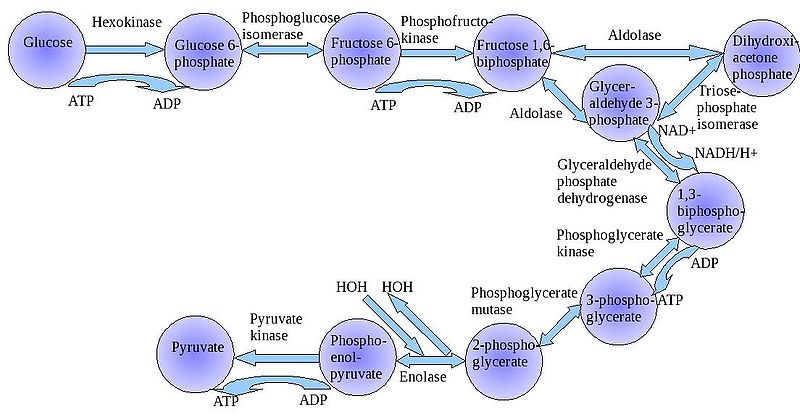
Through this series of reactions, the six-carbon glucose is modified and split into 2 C3 molecules of pyruvate. Glycolysis requires an input of energy to "get the reaction going". This activation energy is provided by 2 ATP. A phosphate is transferred from each ATP to the terminal carbons on the glucose. These phosphates destabilize the glucose. The splitting of the molecule releases energy and high energy electrons. Some of the energy is used to phosphorylate (add a phosphate group to) 4 ADP--> 4 ATP. Thus, although 2 ATP were used to start the reaction, there is a net production of 2 ATP. The high energy electrons are accepted by an important molecule called NAD (nicotinamide adenine dinucleotide). With the acceptance of an electron, each NAD becomes negative charged (NAD-) and reacts with a H+ ion in solution - making NADH. So, NAD is a low energy form of the molecule, and NADH is a high energy form of the molecule. Back to our analogy: So, you've gone to the bank to break the $100 bill (glucose). Maybe they give you 60 $1 bills and 15 euros, worth $2 each. You say, 'hey, that's only equivalent to $90! Yes, there is a 'processing fee' (SECOND LAW) - no energy conversion is 100% efficient! OK, fine. But then you say, "hey, what are these euros? I can't use these! Well, they are another form of low denominational currency. These are theNADH molecules. At some point, in order to USE that energy, you'll have to convert them in ATP ($1 bills). That conversion happens in electron transport chains, as we will see in a bit.
So, for our purposes here, we can summarize glycolysis as:
glucose (C6) + 2 ATP + 2NAD ----> 2 pyruvate (C3) + 4 ATP + 2NADH
b. A problem:
In order for glycolysis to occur (and all subsequent energy-harvesting reactions!!!) the cell must have all three reactants - Glucose, ATP, and NAD. Obviously, if glucose is absent then the cell starves. That's moot. And, As glycolysis proceeds, there is always a net surplus of ATP produced by previous glycolysis reactions. But what about NAD? NAD is converted to NADH... so as glycolysis proceeds, the concentration of NAD drops. If NAD is not present, glycolysis stops (very BAD!!!!!). So, in order to keep metabolism going, NADH must be recycled into NAD. So, NADH must give up its electrons (and H+) to something else, so that the NAD can be recycled and used in glycolysis. This happens two ways, through an electron transport chain (in both aerobic and anaerobic respiration) or through fermentation (essentially, passing the electrons and hydrogen back to pyruvate or a derivative of it).
2. Anaerobic Respiration
These pathways take place in the absence of oxygen. Only some bacteria and archaeans are truly anaerobic. However, these anaerobic processes are VERY important; bacteria that perform these reactions are critical in the nutrient cycling of nitrogen and sulphur, in particular. And, they are critical in your gut, too, where E. coli and other bacteria can respire anaerobically. And archaeans are in your gut, too--the methanogens convernt CO2 to methane (CH4) and H2O and harvest energy from these reactions. These anaerobic reactions are also ancient. Think about this: The first cells evolved about 3.5 billion years ago, and the first eukaryotes evolved about 1.8 billion years ago. So, for nearly 2.0 billion years, life was exclusively bacterial. Oxygen didn't begin to accumulate until 2.5 billion years ago, so for 1 billion years, there was only ANAEROBIC RESPIRATION.
In most anaerobic pathways, the pyruvate is broken into C2 and CO2, and the energy released is harvested in NADH. The C2 acetate molecule is bound to a co-enzyme that catalyzes a reaction with a C4 molecule, binding the two into a molecule of citrate that has six carbons (C6). One carbon is broken off as CO2, energy is trapped in NADH, and the remaining C5 molecule can be changed into a variety of other useful molecules. A problem here is that the C4 molecule is not recycled; energy must be used by the cell to make more of it. So, not only does anaerobic respiration yield less total energy, but some of the yield must be used to replenish ingredients...leaving even less for other needs in the cell.
OK, so, at this point, an anaerobic bacterium has used 2 ATP and produced 4 ATP (in Glycolysis) and 3-4 NADH molecules (glycolysis, pyruvate metabolism, and incomplete Citric Acid Metabolism. Huh. Most of the energy released by breaking C-C bonds has been trapped in NADH, not ATP! How is that problem solved?
Well, actually, it was probably solved first, evolutionarily. Electrons can be transferred between membrane proteins that have different charges and 'electronegativity'. As electrons are pulled from NADH, the NAD and H+ are split and the electron is passed from protein to protein in the membrane, crossing the membrane as it is passed. The H+ protons are attracted to the electron, and they pass through the protein channels, accumulating on the other side of the membrane. The electron is finally passed to an electron acceptor... in anaerobic respiration this can be a number of molecules (NO3, SO4, S, CO2, etc.) but we will use sulphur as the example. A sulphur atom attracts the electron, and is now S-. It grabs another being passed dacross the membrane down the electron transport chain, and is now S= (S-2) In the meantime, H+ ions have built up on one side of the membrane, causing a charge differential (electric potential energy). Then the H+ ions flow back across the membrane through a very specific prtein channel - one that has a specific enzyme attached. This enzyme, ATP synthase, can convert the electrochemical energy of the H+ flow into chemcial bond energy... binding a phosphate group to ADP, making ATP. WOW! So, the energy initially harvested in NADH is converted to chemicla bonds in ATP, and the NAD is freed and recycled, so glycolysis can continue! The H+ ions are now inside the cell again; they react with the S-2, making hydrogen sulphide (H2S). NO OXYGEN WAS USED. This is anaerobic respiration, and it is used by lots of bacteria and was the major energy harvesting reaction for 2 billion years, until oxygen began to accumulate and aerobic respiration evolved.
Anaerobic respiration breaks 4 C-C bonds, releasing 4 molecules of CO2. However, it also leaves alot of energy stored in those C5 molecules that must be converted to other things, and energy must be spend making the C4 oxaloacetate molecules that accept the C2 acetyl group from acetyl-CoA. Aerobic respiration recycles the C5 INTO the C4 oxaloacetate, solving both these problems while harvesting MORE energy! How?
Well, the first step is to complete the Citric Acid Cycle. Essentially, by breaking another CO2 off the C5 molecule, a C4 molecule is created that can be modified to regenerate the intial C4 molecule (oxaloacetate) that can react with Acetyl-CoA! So, by breaking off another CO2, more energy is released that is stored in even more NADH. And, the initial C4 molecule has a more energetic structure than the oxaloacetate (C4). So, this conversion releases more energy, which is stored in ATP, NADH, and a third energy currency molecule, FADH! Now, you may be asking, "why couldn't the anaerobic bacteria just do these reactions, too? Because these reactions are catalyzed by specific enzymes. Genes had to mutate to code for these enzymes, and these reactions could recycle oxaloacetate and yield additional energy, to boot!
OK, what next? Well, you should know: the NADH and FADH can pass their electrons to an electron transport chain. In aerobic bacteria, there are additional proteins in the chain. But the process is the same; H+ ions build up (even more, creating a greater gradient and more 'electrochemical power'), and when they flow through ATP synthase, even more ATP is made! In this case, the electrons are 'pulled' through the chain by a molecule with a greater electronegativity than sulphur: oxygen. Each oxygen atom could 'hold' two electrons, and react with 2 H+ coming through ATP synthase... making water. More energy is harvested. These aerobic bacteria came to dominate the increasingly O2 rich oceans, probably in part because they could harvest more energy from the food they consumed; energy they could use to grow, survive, and reproduce. Aerobic respiration probably evolved about 2.0 billion years ago, in response to the increase in oxygen concentrations. Shortly thereafter, aerobically respiring bacteria were engulfed by other cells but not consumed; rather, the host cells used the ATP produced by these energetically efficient 'bacteria'. These host cells were the first eukaryotes, that evolved about 900 million years ago. Their energetic endosymbionts evolved into the mitochondria present in living eukaryotic cells, today. On average, your cells have about 2000 mitochondria each. Again, they aren't "made" by the cell--they divide within the cell, reproducing themselves. In eukaryotes, the process of aerobic respiration occurs within these organelles. From these ancestral eukaryotes, some absorbed photosynthetic endosymbionts, too; these because the photosynthetic algae and their descendants, the plants. SO - PLEASE KNOW THIS: all eukaryotes (except a couple wierd protists like Giardia), HAVE MITOCHONDRIA - that includes protists, fungi, animals, and PLANTS. Photosynthetic eukaryotoes, the agae and plants, ALSO HAVE chloroplasts.
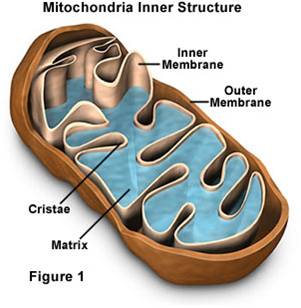 b.
Mitochondrial Structure:
b.
Mitochondrial Structure:
- Mitochondria have a double membrane
system like bacteria and chloroplasts, with an intermembrane space and matrix
within inner membrane.
- They have their own DNA, and they
replicate themselves by fission - they aren't 'made' by the cell.
- Given these observations, Lynn
Margulis hypothesized that these similarities were due to common ancestry, rather
than common environment. She raised this hypothesis as the endosymbiotic
hypothesis of eukaryote evolution, hypothesizing that eukaryotes acquired their
organelles by engulfing free-living bacteria and, rather than digesting them,
simply engulfed them and consumed their products (in this case the ATP that
the bacteria produce. The relationship is called symbiotic, because Margulis
hypothesized that the bacteria would also benefit by being in a stable environment
where the concentration of glucose was high (inside the cell).
- The most direct test of a hypothesis
of relatedness is DNA similarity. DNA only comes from parents, so similarities
imply a common source. When these tests were performed in the 1970's, her hypothesis
was confirmed. Additional tests with choloplasts and basal bodies (other
organielles in eukaryotes) also showed strong patterns of relatedness with free-living
bacteria. As such, we now refer to this tested model as the Endosymbiotic
Theory. We will describe this theory in more detail later in the term...
c. The Details:
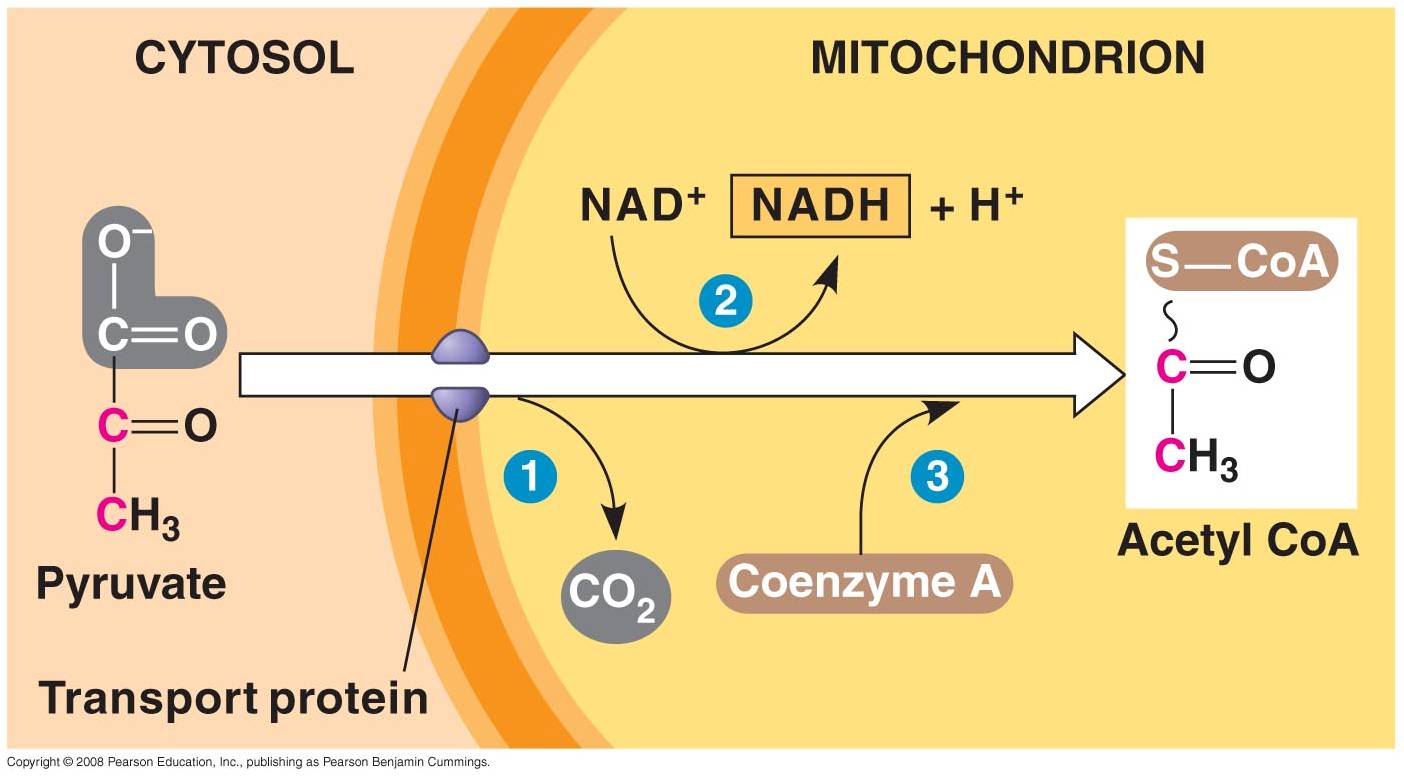 1. 'Gateway' Step:
1. 'Gateway' Step:
- Pyruvates cross both membranes
into the mitochondria and enter the 'matrix' - the cytoplasm of the organelle.
- Each pyruvate reacts with
a Coenzyme A molecule, and is split into a C2-CoA molecule and CO2.
(One C broken off).
- The electrons and energy
released are accepted by NAD, forming 1 NADH for each pyruvate used.
2. Krebs Cycle: 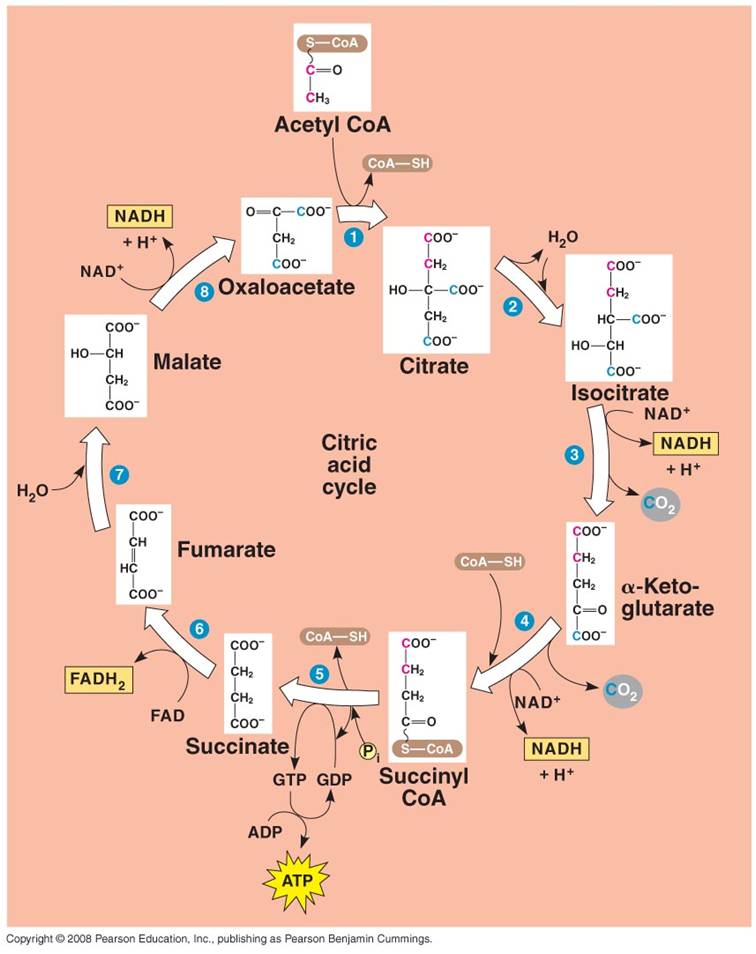
- Each C2-CoA reacts
with a C4 molecule (oxaloacetate).
- The C2 acetate
is transferred to the C4 molecule, forming a C6 molecule
of citrate. (CoA is released and recycled).
- Through a series of reactions,
the 2 'extra' C's are broken off as CO2 molecules and the C4
molecule is regenerated (Cycle).
- Some of the energy released
by the breaking of the C-bonds is used to make 1 ATP, 3 NADH, and 1 FADH2.
3. Electron Tranport Chain:
- Proteins nested in the inner
membrane of the mitochondria accept the electrons from NADH and FADH2
- The electrons are passed
from molecule to molecule, and some of the energy released is used to pump H+
ions across the inner membrane from the matrix to the intermembrane compartment
- Asteep concentration gradient
of H+ ions is formed... this represents chemical potential energy.
- When the ions flow through
protein channels associated with ATP-synthesizing enzymes in the membrane, this
potential energy is transformed into chemical energy in bonds between ADP and
P, making ATP.
- When the electrons reach
a low energy state, they are accepted by oxygen in the matrix and H+ ions react
with the O-- to form water. This is the ONLY use of oxygen in the process
- as an electron acceptor.
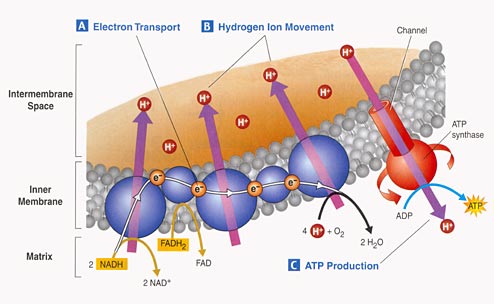
- 34 to 36 ATP are made from the energy tranferred from NADH and FADH2 molecules produced in the Krebs Cycle.
4.FERMENTATION
a. In plants,
fungi, and bacteria:
In the absence of oxygen, the C3 pyruvates are broken into a C2 molecule and CO2. The NADH releases its electron and hydrogen to the C2 molecule, forming ETHANOL (alcohol). The NAD can be recycled and glycolysis can continue, even in the absence of oxygen. This is alcohol fermentation. Of course, the only energy produced by the "glycolysis and fermentation" pathway is a net of 2 ATP per glucose. That is not alot of energy. In a confined environment (like a beer keg or a wine cask), the alcohol concentration may rise to levels that are toxic to the fermenting yeasts. Different yeasts have different tolerances, but even the most tolerant die at about 20% alcohol concentrations. Humans increase the alcohol concentration of fluids by 'distilling' the products of fermentation.
 b.
In bacteria, fungi, and some animal cells:
b.
In bacteria, fungi, and some animal cells:
In lactic acid fermentation, the electron and H+ on NADH is transferred directly
to the C3 pyruvates. This converts them into lactate.
Typically, this type of respiration in animals can only occur for short periods
because the energetic demands for ATP will eventually exceed the rate of production
from glycolysis, alone. At this point, oxygen concentrations must rise
again so that the lactate can be converted back to pyruvate and metabolized
by aerobic respiration. In animal muscle cells, this is known as the 'oxygen
debt', and it is why animals keep breathing hard even after they have stopped
exerting themselves. Short, intensive bursts of activity, usually for up to
two minutes, will burn up available oxygen and cells will rapidly switch to
anaerobic pathways. And of course, the reason these intense activities can't
be sustained for more than 2 minutes at a time is that anaerobic pathways don't
produce enough energy to sustain it! So, you will only be able to run at maximum
speed for a short while... then you stop. Curiously, even though you have stopped
and are not exerting yourself any more, you still breathe heavily for a while.
You are pumping oxygen concentrations back up to normal levels, and processing
the lactate that has built up in your muscle cells. In the presence of oxygen,
the lactate can be convereted back into pyruvate, and then processed in the
reactions described below.
Things to know:
1. You should be able to diagram each step in glycolysis, anaerobic, and aerobic respiration.
2. You should be able to diagram fermentation, and understand why it occurs.
Study Question:
3. Explain how energy initially stored in NADH and FADH is transferred to ATP.